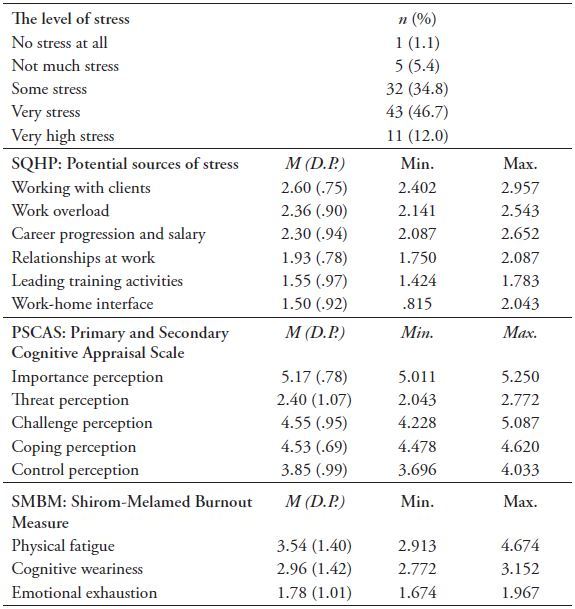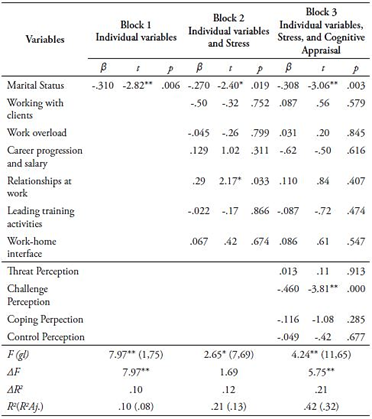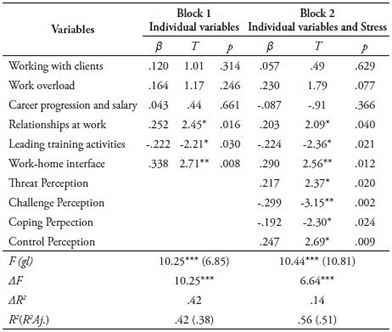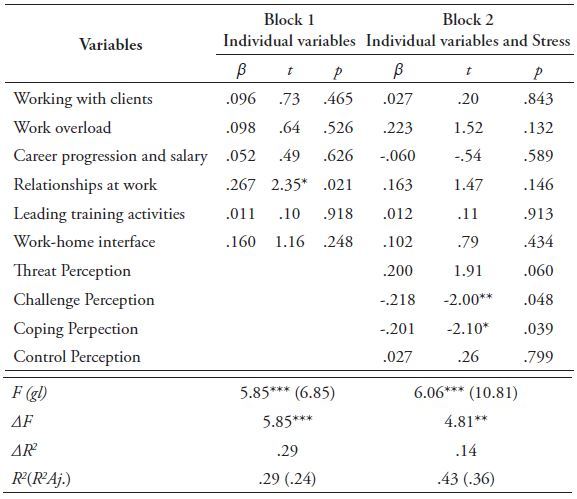Work is an indispensable part of most people’s lives, and it has the potential of bringing positive or negative effects for the workers and organizations (Cooper, 1993). Among its negative impacts, occupational stress and burnout stand out, which are psychosocial problems that have several consequences (Cooper, 1993; Cooper et al., 2001; Rodrigues & Madeira, 2009). Thus, it is important to gather knowledge about these phenomena in order to contribute for the development of coping mechanisms and the creation of healthy work environments where employees can feel valued and satisfied. Curiously, there are much more evidence about the stress and burnout experience in health activities, such as nurses and even doctors (Gomes et al., 2009; Gomes, 2014b; Silva & Gomes, 2009; Simães et al., 2019), but less evidence exists with social workers, even though their work environment presents several risk factors for the development of stress and burnout (Moreno et al., 2014; Sequeira, 2017), as is the case of overwork with little monetary compensation, a pressure to perform tasks, the absence of support resources, and the need to assume multiple responsibilities (Calitz et al., 2014).
Moreover, social workers deal directly with people coming from vulnerable groups (Benevides-Pereira, 2002; Costa, 2003; Costa, 2014; Sequeira, 2017) where processes of violence are intensely present, resulting into first-order demands (Cardoso, 2016). Considering all the demands these professionals are faced with, they tend to be in constant tension (Costa, 2003; Quintana, 2005) which may cause feelings of frustration (Murofuse et al., 2005), and, consequently, the social workers are at risk of cognitive, emotional, and physical exhaustion. Taking into account the negative effects of stress and burnout on the social workers professional performance and on their quality of life there is an imminent need to develop investigations with this population.
Considering these aspects, in this study it was analyzed the factors that contribute to explain the burnout experience of social workers by evaluating the way these professionals evaluated the demands of their activity (sources of occupational stress) and the way they feel about their professional activity (cognitive appraisal). The analysis of these relationships between stress, cognitive appraisal, and burnout was done by adopting the theoretical framework of Interactive Model of Human Adaptation to Stress (Gomes, 2014a), and the cognitive-motivational-related model of stress and emotions proposed by Lazarus (1991, 1999). These models reinforce the need of considering not only the impact produced by the stress on human functioning but also the need of considering processes of cognitive appraisal, both at primary and secondary levels. The primary cognitive appraisal involves the personal evaluation about the significance of a situation, and refers to the importance and challenge perceptions, pointing out the personal relevance of the stressful event to personal values, goals, and beliefs. The secondary cognitive appraisal involves the personal evaluation about the ability to cope with stressors, embracing the perceptions of coping and control over the stressful demands. In this way, stress is the result of external environment demands acting on an individual that are evaluated as threatful and overcoming his/her ability to cope with that demands (Ganster & Perrewé, 2011; Kahn & Byosiere, 1992; Santos & Castro, 1998; Vaz-Serra, 1999).
One possible consequence of negative feelings of the individual when stress overcomes the ability to cope with demands is burnout. Burnout is conceptualized as a syndrome resulting from chronic workplace stress that has not been successfully managed (World Health Organization, 2019). The accumulation of stress causes the professional to be in a state of high emotional exhaustion and to express complaints regarding the level of personal fulfillment (Maslach et al., 1996). Consequently, the resources to deal with the demands of their work are perceived as depleted (Carlotto, 2012; Maroco & Tecedeiro, 2009; Maslach et al., 1996). Thus, burnout is characterized by physical fatigue, emotional exhaustion, and cognitive weariness (Shirom & Melamed, 2006). It differs from stress, because while stress refers to a temporary adaptation process accompanied by physical and mental symptoms, burnout indicates the rupture of the adaptation process, followed by a chronic malfunction (Queirós, 2005). Considering the risk factors for the development of stress and burnout in social workers, the scarcity of studies directed at this population, and the need of adopting an interactive and transactional perceptive of adaptation to stress that includes the role of cognitive appraisal, this study aims to: (a) analyze the burnout and stress levels in the social workers of the sample; b) identify the predictor value of stress and cognitive appraisal to explain the burnout experience of social workers.
Method
This was a quantitative and cross-sectional study, with an exploratory, descriptive, and correlational nature.
Participants
The sample included 92 participants. Most of them was female (n = 88, 90.2%) and 9 were male (9.8%). Regarding the participants’ ages, there was a majority of participants aged between 35 to 49 years old (n = 53, 57.6%), followed by the age group from 25 to 43 years old (n = 30, 32.5%), and the participants which ages were over 50 years old were the minority (n = 9; 9.9%). The greater part of the participants was married (n = 41, 44.6%) and 37 were single (40.2%). Concerning to the academic background, 50 participants had a bachelor’s degree, and the most frequent educational areas were Psychology (n = 31; 33.8%), followed by Social Work (n = 30; 32.7%). Mostly of the participants worked in the residential child care from 1 to 15 years old (n = 77; 83.5%). Regarding to the workload, the greater part of the participants worked from 30 to 40 hours per week (n = 78, 84.8%).
Instruments
Sociodemographic questionnaire. This instrument collected information related to sex, age, marital status, workplace, professional position, contractual situation, professional experience in years, and number of working hours per week.
Stress Questionnaire for Health Professionals. This instrument evaluates the general level of stress in the work activity (one item) and the sources of stress that health professionals face in their activities (25 items distributed across the six stress dimensions): (a) Working with clients (e.g., “Make decisions where mistakes can have serious consequences for my clients”); (b) Work overload (e.g., “Overwork related to bureaucratic tasks”); (c) Career progression and salary (e.g., “No opportunities to progress in my career”); (d) Relationships at work (e.g., “Covert favoritism and/or discrimination in my workplace”; (e) Leading training activities (e.g., “Make public presentations due my duties at work”); (f) Work-home interface (e.g., “Have interpersonal problems with my family and other important persons to me due my responsibilities at work”) (Gomes, 2014a; Gomes et al., 2009; Gomes & Teixeira, 2016). The questionnaire comprises two distinct parts. In the first part, professionals are asked to evaluate the level of stress that they usually feel in their professional activity through a single item (0 = No stress; 2 = Moderate stress; 4 = High stress). In the second part, 25 items are presented regarding the potential sources of stress associated with professional activity. The items are divided in six stress dimensions which evaluate the intensity of stress on a 5-point Likert scale (0 = No stress at all; 2 = Some stress; 4 = Very high stress). Confirmatory Factor Analysis confirmed the six-factor structure of the instrument (χ ^ 2 (258 gl) = 366.34 p <.000; CMIN / DF = 1,420; RMSEA = .067, 90% CI [.051; .083]; CFI = .913; TLI = .898) (Bentler, 2007). The subscale fidelity data was also satisfactory: working with clients (four items; α = .76); work overload (four items; α = .85); career progression and salary (five items; α = .89); relationships at work (five items; α = .75); leading training activities (three items; α = .80); and work-home interface (four items; α = .81).
Primary and Secondary Cognitive Appraisal Scale. This instrument evaluates primary and the secondary appraisals, regarding the professional activity (Gomes, 2014a; Gomes et al., 2013; Gomes & Teixeira, 2016). The Primary cognitive appraisal is evaluated in three dimensions: (a) Importance perception: indicates the extent to which the person evaluates the work activity as significant and important for his/her personal well-being (e.g., “My job means all to me”); (b) Threat perception (e.g., “My job is very disturbing to me”); (c) Challenge perception (e.g., “My job is very exciting to me”). The Secondary cognitive appraisal is evaluated in two dimensions: (d) Coping perception (e.g., “To what extent do you think you are prepared to deal and solve the demands of your job?”); and (e) Control perception (e.g., “To what extent do you feel that what happens in your job depends on you and your abilities?”). The instrument presents 15 items, and each item is measured on a 7-point Likert scale (0 = Is not at all important to me; 6 = Is very important to me, for work importance). Thus, high scores on each scale indicate higher perceptions of each of the dimensions evaluated. Confirmatory Factor Analysis confirmed the single-factor structure of the instrument (χ ^ 2 (80 gl) = 117.303 p <.004; CMIN / DF = 1.466; RMSEA = .072, CI 90% [.041; .098]; CFI = .938; TLI = .919) (Bentler, 2007). The subscale fidelity data was also satisfactory: Importance perception (α = 0.80), Threat perception (α = .74), Coping perception (α = .82), potential for confrontation (α = .87) and Control perception (α = .76).
Shirom-Melamed Burnout Measure. This instrument evaluates the levels of exhaustion at work (Armon et al., 2012; Shirom & Melamed, 2006). The instrument is consisted of 14 items, divided into three subscales: physical fatigue: feelings of physical tiredness at work, resulting in physical energy decrease (e.g., “I feel tired”); cognitive weariness: cognitive wear at work, resulting in the decrease of the ability to think and concentrate (e.g., “My thinking process is slow”); and emotional exhaustion: feelings of emotional exhaustion in the relationships to others (e.g., coworkers, clients), resulting in the decrease of the cordiality and sensitivity to other people’s needs (e.g.: “I feel I am unable to be sensitive to the needs of coworkers and customers”). The subscales and the total scores are merely indicative values of burnout; they do not have diagnostic effects since normative values do not exist yet. However, values equal to or greater than five on the Likert scale may indicate problems in this domain. Items are answered on a 7-point Likert scale (1 = “Never”; 7 = “Always”). The total score is given by the sum of the items of each subscale, dividing this total by the number of items that compose each subscale. Thus, high levels of burnout are associated with higher levels of physical fatigue, emotional exhaustion, and cognitive weariness. Confirmatory Factor Analysis confirmed the factorial structure of the instrument (χ ^ 2 (72 gl) = 108.217 p <.004; CMIN / DF = 1.503; RMSEA = .074, 90% CI [.043; .102]; CFI = .976; TLI = .969) (Bentler, 2007). The subscale fidelity data was also satisfactory: physical fatigue (five items; α = .95), cognitive weariness (five items; α = .97), and emotional exhaustion (four items; α = .87).
Procedures
This study was approved by the Ethical Committee of the institution of the authors of this paper (# REMOVED FOR REVIEW PURPOSE). It counted on the collaboration of 35 residential child care in Portugal North, and 92 valid responses of the social workers to the questionnaires were considered in this investigation.
Analysis Procedure
The collected data were subjected to analysis and treatment using the Statistical Package for Social Science (SPSS, v. 25, Inc. Chicago, IL). In the first phase, descriptive statistical measures (frequencies and averages) were performed to characterize the sample and analyze the levels of stress and burnout. Then, the hierarchical multiple regression (enter method) was used to understand which variables were predictive of the burnout experience.
Results
Descriptive Analysis
Table 1 presents the descriptive statistics that correspond to the different variables under study. Regarding to the potential sources of stress, the dimension “working with clients” was classified by the technicians as the greatest source of stress, while the dimension of “work-home interface” was indicated as the lowest source of stress. Concerning to the burnout factors, the dimension “physical fatigue” was classified by the technicians as the major cause of burnout, while the dimension “emotional exhaustion” was indicated as the lowest one.
Regression Analysis
Before conducting the regression analyzes, we have noted that all participants had attributed importance to their professional activity (subscale of “importance perception” of PSCAS) (Gomes & Teixeira, 2016). Then, we have performed the hierarchical multiple linear regression (enter method) in three blocks. In block 1, marital status was entered as an independent variable. In block 2, we introduced the stress dimensions (SQHP): working with clients, work overload, career progression and salary, relationships at work, leading training activities, and work-home interface. Finally, in block 3, the dimensions of cognitive appraisal (PSCAS) were entered as independent variables: primary cognitive appraisal (threat and challenge perceptions) and secondary cognitive appraisal (coping and control perceptions). Then, an outlier was removed.
Analyzing the results of the regression for the “emotional exhaustion”, the three blocks were statistically significant. As it can be observed in Table 2, in block 1, marital status was a statistically significant predictor of emotional exhaustion, and it explained 8% of the variance. The single people, compared to the married ones, showed more problems of emotional exhaustion. In block 2, the marital status continued to be a statistically significant predictor. From the new variables introduced, we verified that higher stress perception was related to “relationships at work”, which was also a statistically significant predictor. These two predictors explain 13% of the variation in the “emotional exhaustion”. Finally, in block 3, marital status continued to be a statistically significant predictor, but not the “relationships at work”. From the new variables introduced, we have found that higher “challenge perception” was a statistically significant predictor. The final model explained 32% of the variance in the “emotional exhaustion”.
Regarding the linear regression for the “physical fatigue”, it was followed the same procedure of the previous analysis. In this case, marital status did not have a statistically significant correlation with physical fatigue and was not included in the regression analysis. Thus, a regression analysis was performed in two blocks, which proved to be statistically significant. In block 1, “work-home interface”, “relationships at work”, and “leading training activities” were statistically significant predictors of the “physical fatigue” dimension. These predictors explained 38% of the variance in physical fatigue. In block 2, the stress dimensions inserted in the previous block continued to be statistically significant predictors. Analyzing the impact of the “cognitive appraisal” dimensions, higher “control perception” and “threat perception”, as well as lower “challenge perception” and “coping perception” were statistically significant predictors of the “physical fatigue” dimension. The final model explained 51% of the variance in physical fatigue.
Finally, in the linear regression for the “cognitive weariness”, the marital status was not considered again because it did not show a statistically significant correlation with the cognitive weariness dimension. Therefore, the regression analysis was performed in two blocks, which proved to be statistically significant. In block 1, it was entered the stress dimensions and we have found that higher stress perception related to “relationships at work” was significant, which explained 24% of the variance of cognitive weariness. In block 2, it was entered the cognitive appraisal dimensions, and we have verified that lower “challenge perception” and lower “coping perception” were statistically significant predictors for the cognitive weariness, and the final model explained 36% of its variance.
Discussion
Stress and burnout are increasingly common nowadays in work environments and they can lead to several individual and organizational consequences (Cooper, 1993; Cooper et al., 2001; Rodrigues & Madeira, 2009). Social workers of residential child care, given the inherent characteristics of their work, are at a particularly high risk of suffering from the effects of stress and burnout, experiencing negative impacts on their health. For that reason, this study aimed to understand stress, cognitive appraisal, and burnout of residential child care social workers. We explored, specifically, the sources of stress related to work that could predict burnout in social workers, and the importance of the cognitive appraisal processes in stress and burnout. Thereby, this investigation may contribute to increase the knowledge of these individuals’ mental conditions to design and implement interventions to diminish the effects of stress and burnout on these professionals.
Considering the results of stress and burnout, the participants in this study reported high levels of stress and moderate levels of burnout. Analyzing the global level of stress, 34.8% of the social workers reported moderate stress associated with their profession, and more than 58% of the sample mentioned that they felt very stress or very high stress in their professional activity, which is in line with other studies carried out in Portugal, either with psychologists (Gomes & Cruz, 2004), or with teachers (Gomes et al., 2006; Gomes et al., 2013; Pinto et al., 2005; Reisa et al., 2018). The dimensions “dealing with clients”, “work overload”, and “career progression and salary” were pointed out as the greatest sources of stress, which corroborates other studies. For instance, some investigations with health professionals also verified the dimension “dealing with clients” as the greatest source of organizational stress (Gomes, 2014b; Gomes, et al., 2009; Joaquim et al., 2018; Paris & Omar, 2008; Pereira & Gomes, 2016). In the case of the social workers, one of the possible explanations for these results is related to the nature of the work, the need to deal with families coming from high social vulnerability contexts, and the requirements inherent to their activity that imply a work overload oftentimes. As a result, these professionals may perceive that their remuneration does not accompany the professional effort they spend.
Regarding the levels of burnout, analyzing its three dimensions, results showed that the physical fatigue was the most prevalent, followed by cognitive weariness, and, last of all, emotional exhaustion. Thus, it was observed that participants felt exhausted mainly in the physical and cognitive dimensions, and these results are in line with investigations conducted with health professionals (Gonçalves et al., 2019; Lee & Wang’s, 2002), physioterapists (Seixas et al., 2020), caregivers in nursing homes (Vaz, 2013), teachers (Reisa et al., 2018), as well as civil aviation professionals (Baganha et al., 2016).
Concerning to the variables that predict the burnout dimensions and starting with emotional exhaustion, we have found that the variable marital status predicts 8% of this burnout dimension, and single professionals felt emotionally more exhausted than the married ones. The influence of marital status on the experience of burnout does not translate into consensual results in different studies. Although other studies also found that single and divorced professionals tended to experience higher levels of burnout, especially emotional exhaustion (Bauer et al., 2005; Gil-Monte, 2003; Guevara et al., 2004; Maslach et al., 2001), other investigations obtained divergent results, concluding that married professionals had higher levels of burnout (e.g., Cardoso, 2016; HahnMary & Carlotto, 2008). Regarding the stress sources, we verified that there was an explanatory increase in emotional exhaustion due to the stress related to relationships at work, which reinforces that burnout is the result of the existence of chronic and interpersonal stress (Queirós, 2005; Seabra, 2008). Furthermore, taking into account the variables of the cognitive appraisal, this set of variables explained 32% of emotional exhaustion, and the fact that the lower perception of challenge was a predictor of increases in emotional exhaustion, which reinforces the importance of positive cognitive appraisal in adaptation to work conditions (Gomes, 2014a). These results suggest that emotional exhaustion is the result of the interaction of different aspects, such as the individual’s characteristics, and by aspects related to labor activity.
In terms of physical fatigue, 38% of variance was explained by higher stress in relationships at work and work-home interface dimensions, and by lower stress in leading training activities. The introduction of the cognitive appraisal contributed to augment the explained variance of the physical fatigue to 51%. All the dimensions of the cognitive appraisal were significant and it was found that a higher threat perception in conjunction with lower levels of challenge, coping and control perceptions were predictors of this burnout dimension.
Finally, for cognitive weariness, the dimensions of stress introduced in the first block, explained 24% of the variance associated with this burnout dimension. Interestingly, as for emotional exhaustion, a higher stress associated with relationships at work was a significant predictor. In the second block, the cognitive appraisal dimensions were introduced, and the final model predicted 36% of the cognitive weariness variance, confirming that a lower perception of challenge and coping explained this burnout dimension.
All in all, stress and cognitive appraisal represented important variables to explain burnout of social workers. Other investigations confirm the results found in this study. For instance, a study with health professionals (Gonçalves et al., 2019) indicated that physical fatigue, cognitive weariness and emotional exhaustion were predicted by stress dimensions. In addition, a study with civil aviation professionals confirmed stress and cognitive appraisal dimensions were predictive of burnout (Baganha, Gomes & Esteves, 2016). Previously, other studies have demonstrated the occupational stress as a predictor of the responses to work (Esteves & Gomes, 2013; Gomes & Teixeira, 2013) as well as the relevance of the work evaluation by the professionals (Lazarus, 1991, 1999).
This study showed that social workers may be at high risk of suffering from physical fatigue, cognitive weariness, and emotional exhaustion stemming from the presence of high levels of occupational stress. Our data indicates that physical fatigue and cognitive weariness were the burnout dimensions with higher values. Furthermore, cognitive appraisal were important predictors of how these professionals felt in terms of burnout.
Some limitations were present in this study, and they may be considered in future research. Primarily, our sample was limited, and the data interpretation was made using comparisons with studies carried out with other professional groups, especially health professionals. Thus, future research should include other social workers in their samples, to increase professional representativeness. Moreover, it would be important to consider conducting a longitudinal study covering different moments of evaluation in order to expand the analyses.
In sum, our data suggested the relevance of the design and implementation of interventions to diminish the effects of stress and burnout of social workers, promoting the well-being and health of these professionals.



















